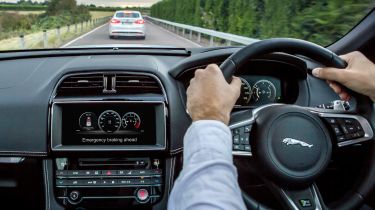Driving in Germany: laws, tips and Autobahn speed limit
Whether you’re heading to Germany on holiday or just passing through using the Autobahn, here’s what you need to know about driving there

Germany is one of the most enjoyable places to drive in Europe. That shouldn’t be a surprise, given the car was invented there, while the country’s stringent rules for both driver training and car maintenance mean both drivers and vehicles tend to be better prepared than in some other countries. To top it off, its derestricted sections of the Autobahn motorway network are among very few places in the world with no speed limit.
The prospect of high-speed roads, new cities and twisting mountain passes can be daunting, particularly if it’s your first time in continental Europe and you aren't yet used to driving on the right side of the road. But if you go prepared, then you can get used to it very quickly, and may well find yourself enjoying it a lot more than driving in the UK.
 Top 10 best motorway cars 2025
Top 10 best motorway cars 2025
In this article we’ll look at everything you need to know about driving in Germany, including what you need to bring with you, driving rules and tips for using the high-speed Autobahn routes.
Remember that if you are taking your own car to Germany, you will most likely also drive through France to get there, so make sure to read our guide before heading off.
Licence rules for driving in Germany
You need to be at least 18 years old to drive in Germany, and hold a full driving licence. Since Germany accepts all EU driving licences as valid there, you don’t need to get an International Driving Permit – just bring your photocard licence with you.
You don’t need to carry an insurance green card with you, but you do need to have valid car insurance to drive in Germany (and while it’s not obligatory, travel insurance is always wise to cover unforeseen events). Check that your provider keeps you covered when driving abroad, and bring a copy of your insurance certificate with you. You can bring your car into Germany for up to six months – longer than the 90 days in any 180 that UK residents can currently spend there visa-free!
If you’re hiring a car you may also need a second form of ID, but since you’re probably coming from the UK you’ll have your passport anyway. The rules vary depending on which rental company you book with, so check before you travel.
Car stickers for driving in Germany
Since September 2021 the old GB stickers and number plates are no longer valid, so you need to get a new country identifier to drive in Germany. This is a white sticker with the letters UK that you display on your car, usually next to the rear number plate.
Alternatively you can get a number plate with the UK letters and a Union Flag for your car if you prefer.
If your car has halogen headlights you will also need to fit headlight deflectors so that your car doesn’t dazzle drivers at night. Since we drive on the left, UK cars’ headlights point slightly to the left to prevent this at home. A set of stickers – readily available online, at motoring shops and even at the channel crossing – can be fitted to your headlights to keep your car safe and legal for just a few pounds.
Some cars, particularly newer ones, have headlights that can be adjusted for driving on the right, which might save you the need to do this. Sometimes it’s done through the car settings on the infotainment system and sometimes there’s a switch on the lights – check your owner’s manual to find out.
What to bring with you to drive in Germany
There are quite a few items that you will need to bring with you to drive in Germany, although it’s not difficult to get yourself prepared. The documents you need to bring with you are: your driving licence photocard, your passport, a certificate of car insurance and your car’s V5C document (or logbook).
Like in many European countries, there are also a handful of safety items that you need to carry with you in the car. These are:
- High-visibility (reflective) jackets
- A warning triangle
- A first-aid kit (for German-registered cars)
- Winter tyres (should be fitted between October and April, but check local regulations, especially in mountainous areas)
In the summer in a UK-registered car you simply need to carry some reflective jackets and a warning triangle, which is easy to comply with. You can buy complete kits for driving in Europe at the ferry port, channel tunnel, or at most automotive shops.
Driving on the Autobahn in Germany
Driving in Germany isn’t actually that different to driving in any other country that drives on the right-hand side, so most drivers new to the country will probably have questions about the one thing that is notably different: the Autobahn (motorway) network, famous for having no speed limits.
In reality, that’s only partly true, as a large proportion of the Autobahn system has a 120km/h limit, clearly indicated by signs and overhead gantries. If you see the black-and-white sign that indicates a de-restricted section, the official recommended speed is 130km/h – but many drivers will drive much faster than that, as there’s no speed limit.
These sections of road might be daunting for some drivers and exciting for others, but everyone should drive with extra care on de-restricted sections. As in the UK, you should stay on the inside lane – in Germany it’s on the right – whenever you aren’t overtaking, only moving into the left-hand lane to overtake after checking your mirrors and indicating to signal your intentions. Check a second time before you move, as cars can approach much faster than you’re used to in other countries.
Assume that any car that appears in your mirrors could be driving at well over 100mph – or even 150mph. Some will flash their lights to signal they are driving quickly and they would like you to move over to let them pass. This isn’t considered an aggressive move like it is in the UK, more like an alert to drivers in front that a much faster car is approaching.
If you are a more confident driver and want to drive faster than is legally allowed in the UK, you should also take much more care when behind the wheel. Before you go, make sure that your car does not have any issues – advisories on the MoT for things like tyres and suspension would indicate that it could be unsafe to drive at over the UK speed limit.
If you’re sure your car is safe – and you don’t notice any vibrations or wobbles as you increase your speed – you can gradually drive faster. If there’s nothing in the inside lane, use it like you normally would and move over to the outside lane in plenty of time to overtake. Look much further up the road – if you see a truck you know you will need to overtake it, and keep an eye on how quickly you approach anything ahead.
You really need to concentrate on looking as far ahead as possible to safely drive at high speed, but luckily the Autobahns are designed to allow excellent visibility. German drivers are also considerate and will generally not stay in the outside lane any longer than necessary. It should go without saying that in bad weather and when you can’t see very far ahead, reduce your speed accordingly. Even the derestricted sections of Autobahn typically have speed limits in poor weather anyway – usually 120km/h (about 75mph) or less, matching restricted sections, depending on how bad the weather is and how much visibility is reduced. Overhead gantry signs will inform you of the new limit.
There are no tolls for the Autobahn network, and there are frequent service areas and rest stops where you can take a break or refuel your car.
Driving on other roads in Germany
Driving in Germany is very pleasant and most of the rules are the same as in the UK – although of course you drive on the other side of the road, so things like roundabouts and junctions are mirrored. Give way to cars arriving from your left at a roundabout, and look both ways at junctions like you always would.
You must wear your seat belt and of course all normal roads have speed limits, clearly indicated by signs. Sometimes if there’s no sign you need to use common sense. In built up areas the limit is 50km/h (31mph) and on country roads it’s 100km/h (62mph). An increasing number of small towns and villages have a 30km/h limit (18mph) now too, though typically in the kind of very tight areas that going any quicker would already be inadvisable.
You’re not allowed to use speed camera detectors in Germany so turn off this function of your sat-nav if it has it. Fines for speeding depend on how much you’ve exceeded the limit by. On-the-spot fines can be handed out by police if you break traffic laws.
Parking isn’t allowed near traffic lights and bus stops, nor should you block access or stop in the bike lane. You also can’t park facing oncoming traffic or anywhere with a no-parking sign.
Some cities and urban areas have environmental rules like our low-emissions zones in the UK. The Umweltzone rules mean you need a sticker with your car’s emissions displayed, so most UK drivers won’t be able to drive in these zones even if their car meets the requirements. Check your rental car has a green emissions sticker before heading into an Umweltzone.
You can also order one online for your own car – but use official sources such as German inspection company Dekra, to ensure you’re getting a genuine sticker. Cars of more than 30 years old are in theory exempt, but you should carry your registration certificate in order to prove the car’s age. Diesels registered before 2000 and petrol cars before 1992 cannot receive a sticker. A sticker is currently around £15, and the fine for not displaying one is around 80 Euros, or just under £70, plus any other charges that may apply.
Children over three years old need to be in the back seats of your car, while anyone under 12 and under 150cm tall needs to be in a child seat. Follow the UK child car seat laws and you’ll be ok here.
The limit for alcohol in the breath in Germany is 50mg per 100 millilitres, which is lower than the UK’s 80mg. It’s always best to avoid drinking altogether if you are driving. There is a zero tolerance policy for those under 21 – the limit is 0 in that case.
If the worst should happen and there’s an emergency, the number to call is 112.
Driving abroad made simple:
Recommended

Beat the Easter weekend traffic: secrets of a stress-free car getaway
Most Popular
Tips & advice

Car dashboard warning lights: what does each symbol mean?

Electric car charging stations: public networks, charger types, apps and maps







